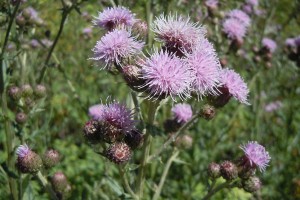Californian thistle stem miner
History in New Zealand
The Californian thistle stem miner is native to Western Europe and was first imported in 2006 by Manaaki Whenua - Landcare Research on behalf of the Californian Thistle Action Group. The first releases of this weevil were made in 2008 and it is not yet known if establishment has been successful. Only a limited number of releases have been made as mass-rearing proved to be difficult. This insect has never been used as a biocontrol agent anywhere else in the world.
How would I find/recognise it and what is its lifecycle?
This agent will be quite hard to see in the field. The adults are small (3–4 mm) and dark grey to black in colour. You may see adults in the spring feeding on thistle leaves. They make holes in the stem at ground level and lay a single egg in each one. The females appear to prefer to lay their eggs in stems which are infected with the Californian thistle rust (Puccinia punctiformis).
See Californian thistle Phoma leaf blight, Californian thistle rust, and Californian thistle white soft rot.
Image: Californian thistle stem miner (Ceratapion onopordi).
Image: Californian thistle stem miner (Ceratapion onopordi).
Tiny whitish larvae hatch out and move upwards to feed inside the stems or downwards to feed in the roots. Even if you split open stems and roots of plants that are visibly wilting or dying, it may be hard to see the larvae because they are so small. Once fully grown, the larvae pupate inside the stems. New adults do not breed until the following spring and hide away during winter in the leaf litter. Little is known at present about the developmental rates of this insect, but it is expected that there will only be one generation produced each year.
Image: Californian stem beetle eggs.
If you do manage to find them, the Californian thistle stem miner is easy to differentiate from other thistle biocontrol agents or insects on thistles. It is also the only insect that you will find feeding inside the thistle stems.
See Californian thistle gall fly, Californian thistle leaf beetle, green thistle beetle.
How does it damage Californian thistle?
The damage is caused by larvae mining in the stems and roots which either kills the plants or reduces the plants’ ability to compete with other vegetation. Weevil attack may also promote systemic infection by the Californian thistle rust, leading to the death of stems.
Will it attack other plants?
This weevil will feed on nodding (Carduus nutans), Scotch (Cirsium vulgare), and variegated (Silybum marianum) thistles, but prefers Californian thistle if they are infected with rust. It may also attack other thistles to a lesser extent. Plants outside the Cardueae tribe are unlikely to be attacked. Most of the plants in this tribe are unwanted introduced thistles except for globe artichoke (Cynara scolymus) and safflower (Carthamus tinctoria). In laboratory tests, the stem miner will attack these plants but given that there are no records of the beetle ever being a pest on these plants in Europe or the USA, damage to these plants in the field is believed to be unlikely to occur.
How effective is it?
The weevil has not been found again since its release.
How can I get the most out of it?
If the stem miner establishes at initial release sites, it would be worth helping to establish them in all areas where they are needed.
How do I select a release site?
Read Guidelines for selecting release sites for biocontrol agents.
How do I collect it for release at other sites?
We expect that the best way to collect these weevils will be using a garden-leaf vacuum machine. You could also use an ordinary vacuum cleaner if you have access to a portable generator. Modify the tube so that the stem miners are collected and not sucked through. Take a sleeve of coarsely woven material, with one end sewn shut and the other end open (old socks or pantyhose could be used) and fit it securely around the end so that it forms a bag in the mouth of the tube.
You will find it easier to vacuum shorter plants because you can form a better seal with the ground. Every 10 minutes or so, take the sleeve off the end and tip the contents into a holding container. We recommend that you shift at least 100 adults in the spring. Use a pooter to separate the weevils from other material collected during the vacuuming process, which may include pasture pests.
How do I manage the release sites?
Avoid any activities that will interfere with the stem miners, such as mowing or herbicide application. If you need to undertake control measures, then avoid the release site.

